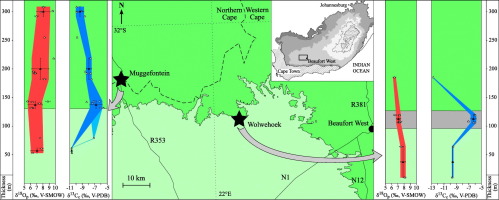当前位置:
X-MOL 学术
›
Gondwana Res.
›
论文详情
Our official English website, www.x-mol.net, welcomes your
feedback! (Note: you will need to create a separate account there.)
Stable isotope record implicates aridification without warming during the late Capitanian mass extinction
Gondwana Research ( IF 7.2 ) Pub Date : 2018-07-01 , DOI: 10.1016/j.gr.2018.02.017 Kévin Rey , Michael O. Day , Romain Amiot , Jean Goedert , Christophe Lécuyer , Judith Sealy , Bruce S. Rubidge
Gondwana Research ( IF 7.2 ) Pub Date : 2018-07-01 , DOI: 10.1016/j.gr.2018.02.017 Kévin Rey , Michael O. Day , Romain Amiot , Jean Goedert , Christophe Lécuyer , Judith Sealy , Bruce S. Rubidge

|
Abstract The late Capitanian mass extinction (~260 million years ago) represents one of the greatest biotic perturbations of the Phanerozoic and was the earliest mass extinction to affect terrestrial tetrapods and ecosystems. In the past, this extinction has been largely associated with taxonomic loss and ecological restructuring in marine environments but more recently it has also been recognised in terrestrial ecosystems. Though various environmental mechanisms have been proposed for the former, little evidence has yet been presented for the cause of terrestrial extinctions. We determined the stable oxygen and carbon isotope compositions of dentine apatite from twenty-eight specimens of the dicynodont therapsid Diictodon feliceps, to investigate the potential role of climate in driving terrestrial tetrapod extinctions. Studied specimens were recovered from a 270 m stratigraphic interval constraining the peak in tetrapod extinction rates in the uppermost Abrahamskraal Formation in the well-sampled main Karoo Basin of South Africa. Our results demonstrate a positive excursion of δ13C values coinciding with the extinction peak that is followed by a return to pre-extinction δ13C values, suggesting a local increase in aridity at the time of the extinction. For the same time interval, the δ18O values did not demonstrate statistically significant changes, suggesting constant temperature in the South African paleoenvironment. This unusual increase in aridity but not in temperature has been interpreted as the possible result of orogenesis in the Cape Fold Mountain source along the southern margin of Gondwana.
中文翻译:

稳定同位素记录表明在卡皮塔尼亚晚期大灭绝期间没有变暖的干旱化
摘要 Capitanian 晚期大灭绝(约 2.6 亿年前)是显生宙最大的生物扰动之一,也是最早影响陆地四足动物和生态系统的大灭绝。过去,这种灭绝在很大程度上与海洋环境中的分类学损失和生态重组有关,但最近在陆地生态系统中也得到了承认。尽管已经为前者提出了各种环境机制,但几乎没有证据表明地球灭绝的原因。我们从 28 个二齿兽兽目二齿兽科动物标本中测定了牙本质磷灰石的稳定氧和碳同位素组成,以研究气候在推动陆地四足动物灭绝方面的潜在作用。研究的标本是从 270 m 地层间隔中恢复的,该间隔限制了南非主要卡鲁盆地中采样良好的最上层亚伯拉罕斯克拉尔组中四足动物灭绝率的峰值。我们的结果表明 δ13C 值的正偏移与灭绝峰值一致,随后返回到灭绝前的 δ13C 值,表明灭绝时局部干旱增加。在相同的时间间隔内,δ18O 值没有表现出统计学上的显着变化,表明南非古环境的温度恒定。这种不寻常的干旱增加而不是温度增加被解释为可能是冈瓦纳大陆南缘开普褶皱山源的造山作用的结果。
更新日期:2018-07-01
中文翻译:

稳定同位素记录表明在卡皮塔尼亚晚期大灭绝期间没有变暖的干旱化
摘要 Capitanian 晚期大灭绝(约 2.6 亿年前)是显生宙最大的生物扰动之一,也是最早影响陆地四足动物和生态系统的大灭绝。过去,这种灭绝在很大程度上与海洋环境中的分类学损失和生态重组有关,但最近在陆地生态系统中也得到了承认。尽管已经为前者提出了各种环境机制,但几乎没有证据表明地球灭绝的原因。我们从 28 个二齿兽兽目二齿兽科动物标本中测定了牙本质磷灰石的稳定氧和碳同位素组成,以研究气候在推动陆地四足动物灭绝方面的潜在作用。研究的标本是从 270 m 地层间隔中恢复的,该间隔限制了南非主要卡鲁盆地中采样良好的最上层亚伯拉罕斯克拉尔组中四足动物灭绝率的峰值。我们的结果表明 δ13C 值的正偏移与灭绝峰值一致,随后返回到灭绝前的 δ13C 值,表明灭绝时局部干旱增加。在相同的时间间隔内,δ18O 值没有表现出统计学上的显着变化,表明南非古环境的温度恒定。这种不寻常的干旱增加而不是温度增加被解释为可能是冈瓦纳大陆南缘开普褶皱山源的造山作用的结果。











































 京公网安备 11010802027423号
京公网安备 11010802027423号